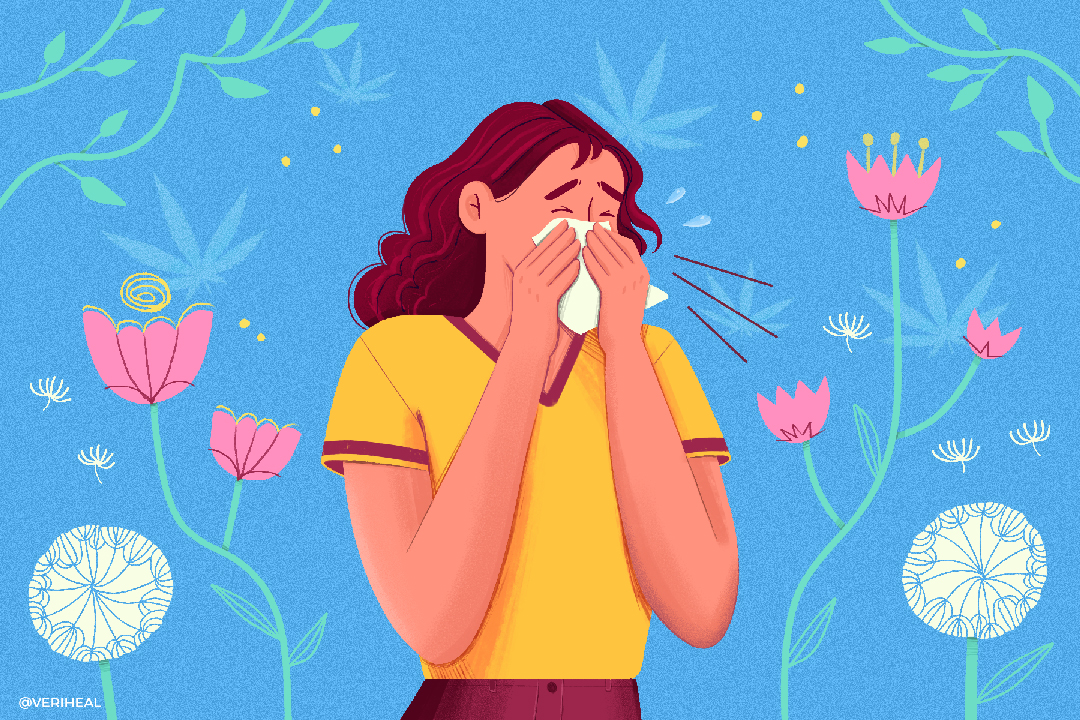The manner in which cannabis interacts with medications is important to understand in order to avoid any adverse interactions. Antihistamines are a type of over-the-counter (OTC) medication that is commonly used to treat allergies, anxiety, rashes, etc. There are currently no studies available on the interaction between cannabis and antihistamines. However, there may be some risks associated with combining cannabis and a type of antihistamine called hydroxyzine.
What Is Hydroxyzine?
Hydroxyzine is an antihistamine that treats symptoms associated with allergies by blocking histamine, the natural substances produced by your body during an allergic reaction, explains WebMD. Hydroxyzine is available as the brand name pharmaceuticals Vistaril and Atarax, which are usually taken under a doctor’s direction. WebMD goes on to explain that the dosage is based on aspects such as one’s age, medical condition, and response to the treatment. It is usually consumed three-four times daily.
As expected, this antihistamine is used to treat symptoms that occur as a result of an allergen. However, this specific antihistamine is used on a longer-term basis to treat itching caused by allergies. It is only used short-term to treat anxiety and other allergy symptoms, or to induce drowsiness or relaxation before and after surgery.
Side effects to be aware of include drowsiness, dizziness, blurred vision, constipation, or dry mouth. WebMD explains that there are more serious side effects including the possibility of experiencing seizures, fast/irregular heartbeats, severe dizziness, and even fainting. Some people even experience allergic reactions to this drug. While instances of allergic reactions are rare, those who experience an allergic reaction to hydroxyzine are likely to experience rashes, itching, swelling, trouble breaking, and/or severe dizziness.
What Are the Risks of Combining Cannabis and Hydroxyzine?
Combining cannabis and hydroxyzine share some similar side effects and consuming them together could result in enhanced effects, warns MedicalNewsToday (MNT). For example, when individuals consume cannabis in a high quantity or with high THC potency, there is the possibility of experiencing adverse effects like dizziness, dry mouth, fast/irregular heartbeats, etc., which are similar to the side effects associated with hydroxyzine.
MNT goes on to explain that the medical label for hydroxyzine does not mention any adverse interactions when consuming the antihistamine in tandem with cannabis. There is currently no indication that cannabis impacts the effectiveness of hydroxyzine and vice versa. However, there are other ways for two substances to interact that does not impact their effectiveness.
That being said, it is important to understand that the following potential risks associated with combining cannabis and hydroxyzine are based on available information and logic, not available peer-reviewed research. So, why mention potential risks if they have not been proven? Well, in the area of cannabis research there is much that has not been studied due to decades of inactivity caused by cannabis prohibition. It’s common sense to take precautions even if there isn’t a study available that explicitly lays out the risks.
Potential Risks of Combining Cannabis and Hydroxyzine:
This potential risk stems from the fact that the two substances can have similar side-effects/ adverse-effects. If you consume a hydroxyzine-based antihistamine and shortly after consume cannabis you may experienced heightened effects. For example, hydroxyzine can make you feel drowsy, which is then boosted with cannabis, which can intensify drowsiness.
Why You Should Get Your Medical Marijuana Card
Veriheal has satisfied millions of patients nationwide by giving them access to these benefits
- Larger purchase limits
- Peace of mind
- Enhanced legal protection
- Access to higher potency strains
- Save up to 25% on cannabis purchases
- Skip the line at the dispensary
While that may not sound so bad, it is one of the least worrisome side effects. Intensified dizziness, dry mouth, irregular heart beats etc. can prove to be dangerous. An example of a more serious circumstance centers around blood pressure and the potential of fainting.
MNT explains that cannabis lowers blood pressure, which can then increase risk of fainting, which is also true of hydroxyzine. Using these two together can then drop your blood pressure to dangerously low levels and put you at an increased risk of fainting.
MNT explains that each substance causes their own effects which may be intensified when combined. However, there is a chance that the combination of cannabis and hydroxyzine can cause unusual effects, such as nausea, suggests MNT. However, these unusual effects can not be cataloged like the individual effects of each substance.
The effects of either substance can be felt to varying degrees in an individual. When the two are combined, it may result in effects which are more noticeable and perhaps more debilitating. While this would be a good thing if the effects were solely relief, considering the adverse effects, increased prominence may have negative outcomes for specific individuals.
- Additional Drug/Substance Consumption
If the risks associated with combining cannabis and pharmaceuticals were not enough to dissuade a person from this course of action, consuming an additional substance in concert with the two, such as alcohol, could have negative outcomes. MNT explains that adding a third substance into the mix can increase one’s risk of being uncoordinated, for example, as well as even increasing the risk of “overdosing on certain drugs.”
Cannabis as an Alternative to Antihistamine
The benefit of having access to an antihistamine when the alternative is an allergic reaction—which can be life threatening—in undeniable. However, it is inadvisable to combine cannabis with hydroxyzine, or really any pharmaceutical, considering the known risks and the unknown adverse interactions that may occur. If cannabis is something you consume regularly, consider using it as a natural antihistamine.
Cannabis, particularly cannabidiol (CBD), has immunosuppressive and anti-inflammatory properties which may act as a natural antihistamine. While this is not a recommendation to replace antihistamines with cannabis, it is rather a recommendation to consider maintaining allergies, such as seasonal ones, with cannabis. If you would like to find out more on how cannabis can assist you with your allergies, be sure to check out these benefits of CBD.
There may be a lack of research concerning the combined consumption of cannabis and hydroxyzine, but the potential adverse effects are serious and should be cause for caution. If you are consuming medicinal cannabis for a particular condition along with consuming hydroxyzine for allergies, consult with your doctor or a medical health professional to discuss antihistamine alternatives to hydroxyzine which can still be equally beneficial but less risky when combined with cannabis.
The content on this page is for informational purposes only and is not intended to be professional medical advice. Do not attempt to self-diagnose or prescribe treatment based on the information provided. Always consult a physician before making any decision on the treatment of a medical condition.
Author, Share & Comments
















